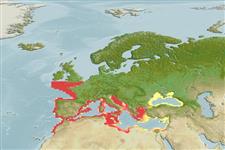Environment: milieu / climate zone / depth range / distribution range
Ecologie
marien demersaal; diepte 10 - 400 m. Subtropical; 51°N - 30°N, 11°W - 42°E
Southeast Atlantic: Atlantic coast from Morocco to the English Channel. Also known from the Mediterranean and Black Sea.
Lengte bij maturiteit / Grootte / Gewicht / Leeftijd
Maturity: Lm 10.0 range ? - ? cm
Max length : 20.0 cm TL mannelijk / geslacht onbekend; (Ref. 3397)
Dorsale stekels (totaal) : 11 - 12; Dorsale zachte stralen (totaal) : 14 - 16; Anale stekels: 2; Anale zachte stralen: 15 - 16. Gill membranes not forming a fold across isthmus. Tentacles on nasal opening, above eye and on nape near first dorsal fin ray. Dentaries joined by suture. Lateral line reduced, discontinuous. Anterior part of dorsal fin conspicuously higher than posterior part.
Adults are found over hard bottoms. Mainly nocturnal, they feed on small invertebrates. Oviparous. Eggs are demersal and adhesive (Ref. 205), and are attached to the substrate via a filamentous, adhesive pad or pedestal (Ref. 94114). Eggs are laid under mussel-shells or stones and guarded by the male (Ref. 5981). Larvae are planktonic, often found in shallow, coastal waters (Ref. 94114). Spawn in April (Marseille) or July (England) (Ref. 5981).
Eggs are laid under mussel-shells or stones and guarded by male (Ref. 5981).
Wheeler, A., 1992. A list of the common and scientific names of fishes of the British Isles. J. Fish Biol. 41(suppl.A):1-37. (Ref. 5204)
Status op de Rode Lijst van het IUCN (Ref. 130435)
Gevaar voor de mens
Harmless
Gebruik door de mens
Visserij: van minder commercieel belang
Tools
Speciale rapporten
Download XML
Internetbronnen
Estimates based on models
Preferred temperature (Ref.
123201): 11 - 17.1, mean 13.9 °C (based on 237 cells).
Fylogenetische diversiteitsindex (Ref.
82804): PD
50 = 0.7500 [Uniqueness, from 0.5 = low to 2.0 = high].
Bayesian length-weight: a=0.00832 (0.00644 - 0.01074), b=3.01 (2.93 - 3.09), in cm total length, based on LWR estimates for this species (Ref.
93245).
Trofisch niveau (Ref.
69278): 3.5 ±0.43 se; based on food items.
Weerstandsvermogen (Ref.
120179): Gemiddeld, minimale populatieverdubbelingstijd 1,4-4,4 jaar (Preliminary K or Fecundity.).
Fishing Vulnerability (Ref.
59153): Low vulnerability (10 of 100).
Nutrients (Ref.
124155): Calcium = 80 [19, 235] mg/100g; Iron = 1.14 [0.42, 4.30] mg/100g; Protein = 3.21 [0.00, 6.94] %; Omega3 = 0.348 [0.150, 0.795] g/100g; Selenium = 23.3 [4.9, 67.0] μg/100g; VitaminA = 18.7 [6.0, 56.8] μg/100g; Zinc = 0.869 [0.449, 1.739] mg/100g (wet weight);
